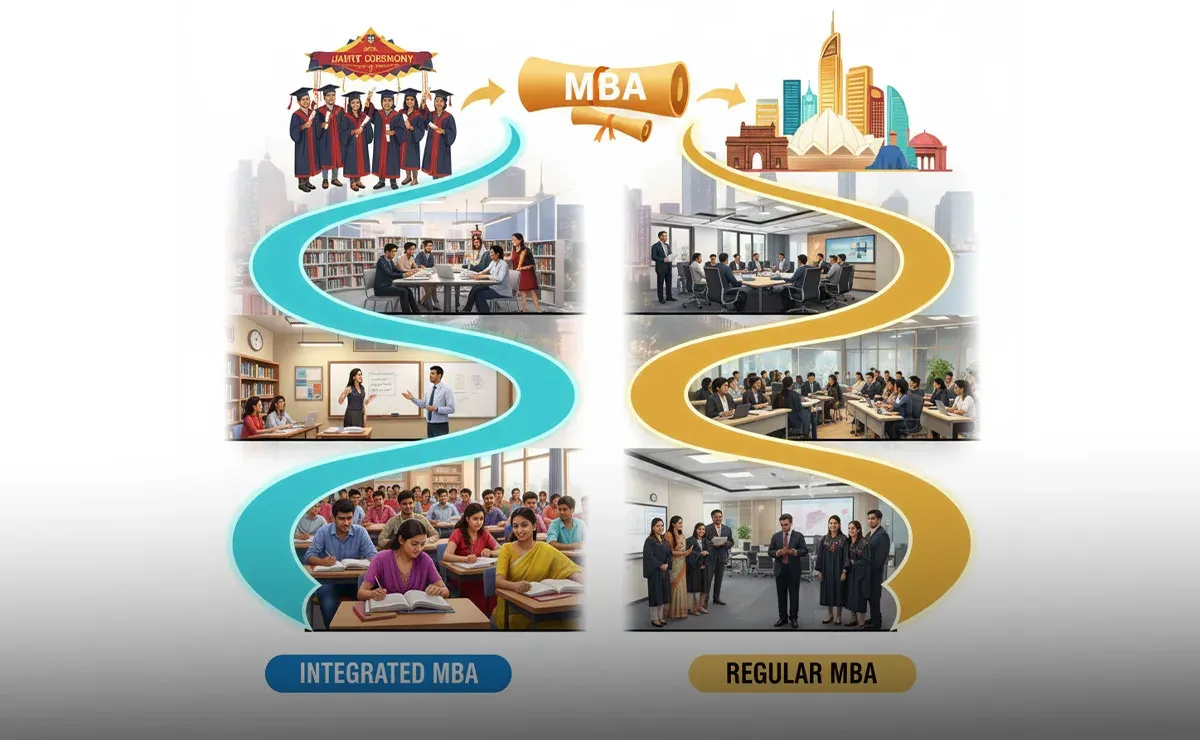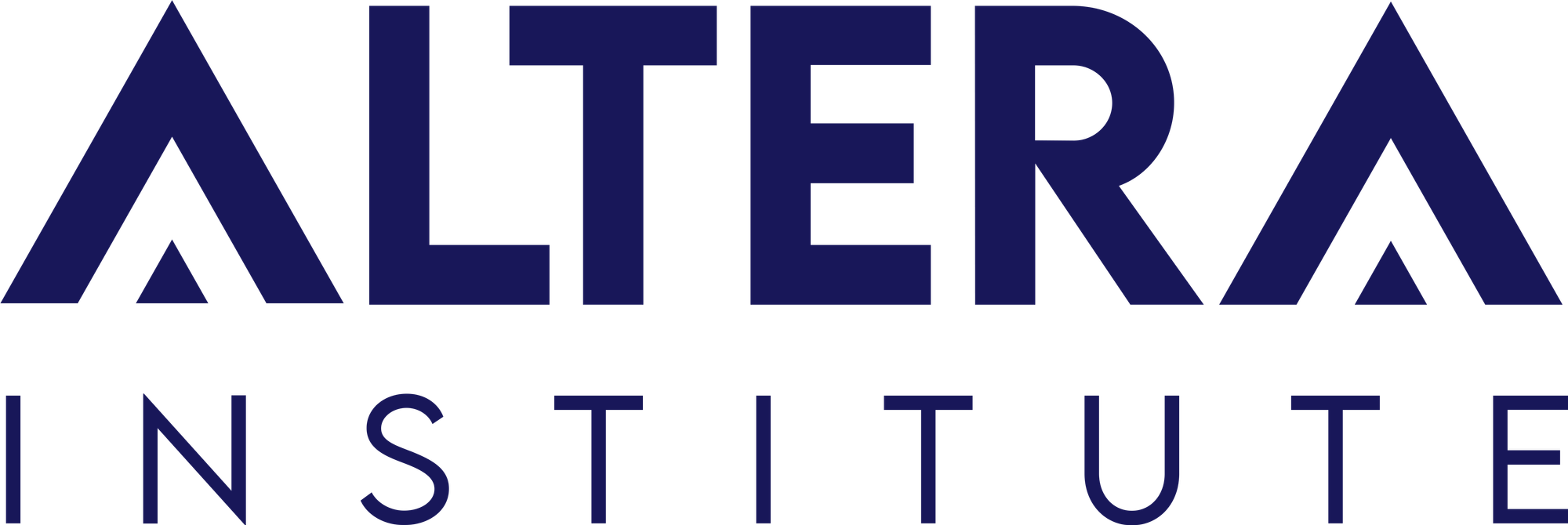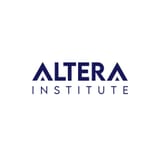What is an Integrated MBA?

The digital age of India is fundamentally reshaping how future business leaders are being developed, with the MBA education market projected to reach ₹19.13 billion by 2033 at a compound annual growth rate of 7.63%. This growth trajectory positions integrated management programs as increasingly strategic educational pathways for India's substantial higher education cohort of 43.3 million students.
An integrated MBA is a 5-year program combining undergraduate (BBA) and postgraduate (MBA) education, allowing direct entry after Class 12. This streamlined approach eliminates separate entrance requirements for MBA admission and provides early career acceleration for management-focused students.
This article explores what integrated MBA programs entail, their unique structure and benefits, key differences from regular MBA programs, and why they represent a compelling choice for students committed to management careers.
Key Statistics and Facts
- MBA graduates achieved a remarkable 78% employability rate in 2025, representing a 66% increase from 47% in 2021, with integrated programs contributing significantly to this growth.
- Only about 2.7% of students enroll in undergraduate management programs after Class 12, as per the AISHE 2021-22 report, with engineering and technology leading at 11.8%.
- BBA graduates comprise nearly 30% of MBA students at many non-IIM business schools, demonstrating a clear demand for advanced management education to support career advancement.
- A substantial curriculum overlap exists between BBA and MBA curricula, leading to redundancy in standalone UG and PG management education.
- The five-year Integrated BBA-MBA Program in Management (IPM) was first launched in 2011 by IIM Indore and has expanded to six more IIMs and other central and private institutions.
- Admissions to the Integrated Program in Management (IMP) are done via national-level competitive exams like IPMAT (IIM Indore) and JIPMAT (NTA), and private universities use tests like NPAT.
- In 2025, the IPMAT Indore witnessed applications from 30,220 candidates, leading to 818 of them being shortlisted for the interview phase.
Understanding Integrated MBA

An Integrated MBA represents a paradigm shift in management education, combining the foundational elements of business administration with advanced strategic management concepts in a seamless five-year journey.
Unlike traditional paths requiring separate undergraduate completion followed by MBA entrance examinations, this integrated approach provides direct access to comprehensive business education immediately after Class 12.
The program structure typically follows a 3+2 model, where the first three years focus on business fundamentals, including economics, statistics, financial accounting, and communication skills, while the final two years concentrate on advanced management topics such as strategy, leadership, and specialized domain knowledge.
Integrated MBA programs in India help address a critical gap in Indian higher education by providing continuous, uninterrupted learning from foundational business concepts to advanced management strategies.
Structure of an Integrated MBA
The structure of an Integrated MBA program in India follows this framework:
Program Duration and Format
- The Integrated Program in Management (IPM) is a five-year full-time program after Class 12.
- It is typically divided into 15 terms (semesters/trimesters) spread over 5 years, with each year having 3 terms of approximately 3 months each.
- The program's 3+2 structure dedicates the initial three years to foundational undergraduate studies, followed by two years centered on the institute's flagship MBA curriculum.
Curriculum Overview
First Three Years (Undergraduate Phase - BBA Level)
Holistic foundational development in subjects across diverse disciplines, including:
- Humanities (economics, literature, history, sociology, and psychology).
- Mathematics (business mathematics, calculus, statistics, quantitative techniques).
- Philosophical and cultural studies (Indian Knowledge System, Indian Constitution, History and Culture).
- Communication skills, critical thinking, problem solving, creativity, and leadership development.
- Basic computer programming and data analytics knowledge.
Experiential learning through:
- Internships usually after the 2nd year or 5th term.
- Focused role-specific business internships between the 4th and 5th years.
- Live projects, field assignments, case simulations, and mentorship.
The program also provides opportunities for international exchange programs at the end of the 3rd year. Multiple exit options are available, as students completing the 3-year requirement may exit with a Bachelor of Business Administration (BBA) degree.
Last Two Years (Postgraduate Phase - MBA Level)
The curriculum merges with the flagship 2-year MBA program in the final two years, where students engage with advanced management subjects such as:
- Finance, marketing, human resources, operations, strategy, and business Analytics.
- Emerging fields like artificial intelligence, technology management, and data science.
The last two years involve intense academic rigor, matching regular MBA standards as well as industry internships, placements, and corporate projects. Specialization streams are available for students to select, enabling alignment with both their professional aspirations and prevailing industry dynamics.
Credit System and Academic Requirements
- Students are expected to maintain a minimum CGPA (usually around 5.0 - 6.0 on a 10-point scale) after undergraduate years to qualify for the MBA segment.
- Academic policies and disciplinary standards must be met to continue progression into the postgraduate phase.
This structure ensures that students develop a firm foundational base before deep diving into specialized management education, catering to holistic, industry-ready managerial skills aligned with future corporate demands.
Benefits of Integrated MBA
In an evolving business landscape, the integrated MBA has emerged as a powerful strategic pathway for ambitious students. By combining undergraduate and postgraduate studies into a seamless five-year program, it delivers a significant competitive edge, positioning graduates for immediate and long-term success.
1) Immediate Career Acceleration and Financial Advantage
An integrated MBA fundamentally alters your career starting point. Instead of beginning in entry-level roles, graduates are positioned for managerial tracks from day one.
This translates into a substantial starting package, which is significantly higher than the average ₹3.5-4.5 LPA salary for standalone BBA graduates. This model also condenses learning into a streamlined timeline, allowing you to begin making a strategic impact at a younger age.
2) Holistic and Future-Ready Skill Development
An integrated MBA curriculum is designed for depth and continuity. It seamlessly blends core business fundamentals with specialized expertise in high-demand areas like analytics, AI, finance, and marketing.
This extended, uninterrupted learning period fosters a unique blend of technical knowledge and strategic business acumen, developing crucial competencies in problem-solving, decision-making, and leadership that are immediately applicable in the workplace.
3) Superior Market Positioning and Career Flexibility
Graduates from recognized integrated programs are highly valued by top-tier employers across sectors like consulting, technology, banking, and FMCG. The extended duration allows for deeper industry immersion through multiple internships and live projects, building a robust portfolio before graduation.
This results in access to exclusive campus recruitment drives with leading national and multinational companies, providing a launchpad into high-growth careers.
4) Exceptional Return on Investment (ROI)
Beyond initial figures, the program is structured for long-term financial benefits. It delivers an exceptional return on investment through a consolidated, financially efficient model that integrates undergraduate and postgraduate education.
Students save significantly on the cumulative expenses of separate degree applications, exam preparations, and gap years. This efficient model allows for a focused investment in your education, maximizing value and minimizing financial fragmentation.
5) A Foundation for Lifelong Career Agility
The comprehensive educational pathway provides a solid foundation that enables graduates to pivot across industries and functions throughout their careers. The alumni network and relationships that students build over five years with faculty and peers become a lifelong professional asset.
Furthermore, the curriculum increasingly integrates future-focused subjects like digital literacy and sustainability, ensuring graduates are equipped not just for their first job but for the evolving demands of global business leadership.
Key Differences Between an Integrated MBA & a Regular MBA Program

The landscape of business education has undergone a significant transformation as institutions adapt to evolving industry demands, student aspirations, and technological advancements. Integrated MBA and Regular MBA programs represent distinct pathways to management careers. Their key differences include:
Aspect | Integrated MBA | Regular MBA |
Program Duration | Five-year continuous program combining undergraduate (BBA) and postgraduate (MBA) studies in one seamless journey. | Two-year intensive program following completion of a separate three-year bachelor's degree. |
Entry Requirements | Direct entry after Class 12 with entrance exams like IPMAT and JIPMAT; typically requires 60% in Class 10 and 12. | Bachelor's degree completion plus competitive exams like CAT, GMAT, or GRE. |
Target Audience | Career-focused students aged 17-18 with clear management aspirations and early commitment to business leadership. | Fresh graduates and working professionals aiming for career progression, industry transitions, or the acquisition of specialized management expertise. |
Curriculum Structure | Progressive skill building with foundational subjects (economics, mathematics, communication) in the first 3 years, followed by advanced management topics (finance, marketing, strategy) in the final 2 years. | Intensive specialized management training focused on strategic leadership, advanced business concepts, and industry-specific expertise over 2 years. |
Flexibility and Options | Limited flexibility once enrolled; requires early commitment to a management career with minimal opportunity to explore other fields. | High flexibility to change career direction; allows exploration of different industries and roles before MBA specialization. |
Skill Development Focus | Continuous management skill building which develops both theoretical knowledge and practical business acumen over an extended period. | Concentrated advanced skill development building on prior work experience; focuses on strategic thinking and executive decision-making. |
The choice between an Integrated MBA and a regular 2-year MBA ultimately depends on whether students prioritize early career acceleration and cost efficiency or prefer gaining work experience to gain more clarity about their goals before advanced management education.
Summing Up
In conclusion, pursuing an Integrated MBA in India offers a transformative educational journey that enables students to enter the workforce earlier, accelerate their career growth, and build a solid foundation of holistic and future-ready management skills.
The program’s design not only delivers superior return on investment by consolidating time and costs but also equips graduates with continuous, industry-relevant learning experiences, including immersive internships and advanced specialization aligned with evolving corporate demands.
Ultimately, an Integrated MBA program in India truly represents a compelling pathway for ambitious young students to fast-track their leadership potential and secure long-term success in India’s dynamic and competitive business landscape.





